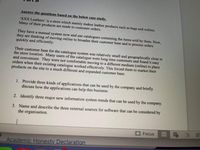
Computer Networking: A Top-Down Approach (7th Edition)
7th Edition
ISBN: 9780133594140
Author: James Kurose, Keith Ross
Publisher: PEARSON
expand_more
expand_more
format_list_bulleted
Question

Transcribed Image Text:Answer the questions based on the below case study.
'XXX Leathers' is a store which mainly makes leather products such as bags and wallets.
Many of their products are made to customer orders.
They have a manual system now and use catalogues containing the items sold by them. Now,
they are thinking of moving online to broaden their customer base and to process orders
quickly and efficiently.
Their customer base for the catalogue system was relatively small and geographically close to
the store location. Many users of the catalogue were long time customers and found it easy
and convenient. They were not comfortable moving to a different medium (online) to place
orders when their existing catalogue worked effectively. This forced them to market their
products on the site to a much different and expanded customer base.
1. Provide three kinds of applications that can be used by the company and briefly
discuss how the applications can help this business.
2. Identify three major new information system trends that can be used by the company.
3. Name and describe the three external sources for software that can be considered by
the organisation.
Focus
目 =三
Academic Honestyv Declaration

Transcribed Image Text:Your Answer: a
2. Following is NOT a feature of an organisation's information value chain.
a) It results higher firm profitability.
b) Raw information is transformed through various stages that add value to that
information.
c) It provides less efficient business processes.
d) Raw information is systematically acquired
e) It helps organisations to reduce operational cost.
Your Answer :
3. How do flat organisations differ from traditional organisational hierarchies?
a) Flat organisations try to increase number of staff.
b) Flat organisations allow all employees to access the same data as its top managers.
c) In Flat organisations, each employee role belongs to a department.
d) Flat organisations force to have middle managers in the hierarchy.
e)
organisations do not eliminate management hierarchy.
Your Answer:
Expert Solution
This question has been solved!
Explore an expertly crafted, step-by-step solution for a thorough understanding of key concepts.
Step by stepSolved in 3 steps

Knowledge Booster
Similar questions
- First, outline the framework construction challenges you expect. Then, examine the challenges you expect to encounter while integrating each of the prospective solutions. Cloud computing may solve the issues. Do you have to notice everything, even if it happens repeatedly?arrow_forwardIn order to overcome the challenges you may encounter when developing the framework, you must first identify those challenges. Potential solutions might be found via cloud computing. Do we really need to pay attention to everything that happens, even if we've seen it before?arrow_forwardYou should think about the difficulties you'll have when constructing the framework, and then look into the roadblocks and issues that come up with each potential solution. Can these issues be addressed by using cloud computing? Is it crucial that I worry about this?arrow_forward
arrow_back_ios
arrow_forward_ios
Recommended textbooks for you
 Computer Networking: A Top-Down Approach (7th Edi...Computer EngineeringISBN:9780133594140Author:James Kurose, Keith RossPublisher:PEARSON
Computer Networking: A Top-Down Approach (7th Edi...Computer EngineeringISBN:9780133594140Author:James Kurose, Keith RossPublisher:PEARSON Computer Organization and Design MIPS Edition, Fi...Computer EngineeringISBN:9780124077263Author:David A. Patterson, John L. HennessyPublisher:Elsevier Science
Computer Organization and Design MIPS Edition, Fi...Computer EngineeringISBN:9780124077263Author:David A. Patterson, John L. HennessyPublisher:Elsevier Science Network+ Guide to Networks (MindTap Course List)Computer EngineeringISBN:9781337569330Author:Jill West, Tamara Dean, Jean AndrewsPublisher:Cengage Learning
Network+ Guide to Networks (MindTap Course List)Computer EngineeringISBN:9781337569330Author:Jill West, Tamara Dean, Jean AndrewsPublisher:Cengage Learning Concepts of Database ManagementComputer EngineeringISBN:9781337093422Author:Joy L. Starks, Philip J. Pratt, Mary Z. LastPublisher:Cengage Learning
Concepts of Database ManagementComputer EngineeringISBN:9781337093422Author:Joy L. Starks, Philip J. Pratt, Mary Z. LastPublisher:Cengage Learning Prelude to ProgrammingComputer EngineeringISBN:9780133750423Author:VENIT, StewartPublisher:Pearson Education
Prelude to ProgrammingComputer EngineeringISBN:9780133750423Author:VENIT, StewartPublisher:Pearson Education Sc Business Data Communications and Networking, T...Computer EngineeringISBN:9781119368830Author:FITZGERALDPublisher:WILEY
Sc Business Data Communications and Networking, T...Computer EngineeringISBN:9781119368830Author:FITZGERALDPublisher:WILEY

Computer Networking: A Top-Down Approach (7th Edi...
Computer Engineering
ISBN:9780133594140
Author:James Kurose, Keith Ross
Publisher:PEARSON

Computer Organization and Design MIPS Edition, Fi...
Computer Engineering
ISBN:9780124077263
Author:David A. Patterson, John L. Hennessy
Publisher:Elsevier Science

Network+ Guide to Networks (MindTap Course List)
Computer Engineering
ISBN:9781337569330
Author:Jill West, Tamara Dean, Jean Andrews
Publisher:Cengage Learning

Concepts of Database Management
Computer Engineering
ISBN:9781337093422
Author:Joy L. Starks, Philip J. Pratt, Mary Z. Last
Publisher:Cengage Learning

Prelude to Programming
Computer Engineering
ISBN:9780133750423
Author:VENIT, Stewart
Publisher:Pearson Education

Sc Business Data Communications and Networking, T...
Computer Engineering
ISBN:9781119368830
Author:FITZGERALD
Publisher:WILEY